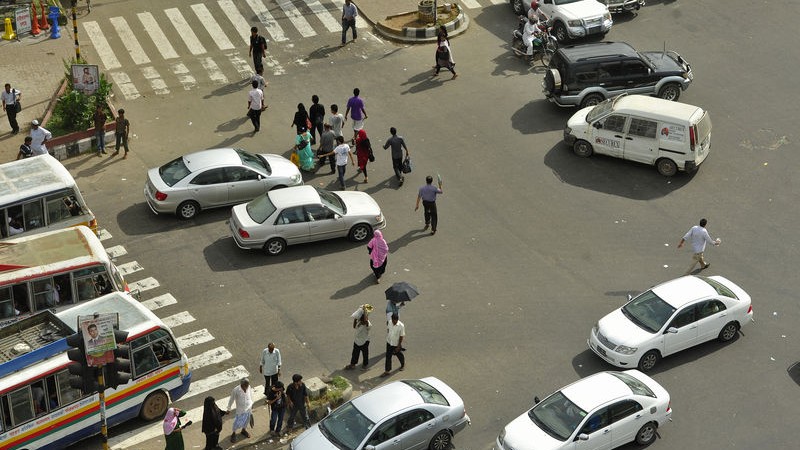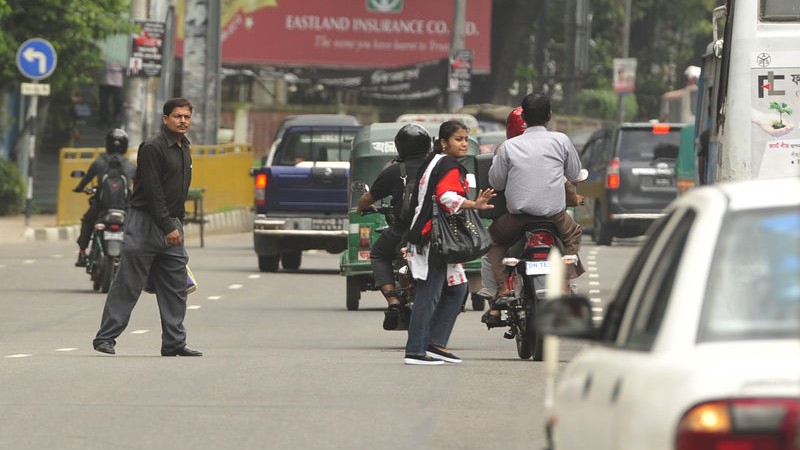
Citizens risk their lives to cross roads at Kazi Nazrul Islam Avenue in the capital, just yards away there is a crosswalk on the other side. Image by Firoz Ahmed. Copyright Demotix (30/8/2012)
Bangladesh police completed a three-day campaign in late November to stop pedestrians from crossing busy roads without using footbridges or underpasses. The authorities have also established mobile courts to punish the hundreds of pedestrians who jaywalk with fines and sometimes even imprisonment.
According to police, this is an awareness campaign. People in Bangladesh often cross busy roads by stepping into traffic, stopping oncoming vehicles with a wave of the hand, rather than using the footbridges built for pedestrians. The behavior is both a public safety hazard and a problem for managing traffic.
The crackdown on jaywalking is not without its critics.
Commenting on a news story online, one Internet user says the pedestrian bridges are far from accommodating:
ফুটওভার ব্রিজগুলোতে ওঠানামা করতে খুব কষ্ট হয়। সুস্থ লোকও হাপিয়ে যায়। আন্ডারপাসে ওঠানামাও কষ্টকর। তাই জরিমানা করার আগে এসব প্রতিবন্ধকতা দূর করা দরকার। বিজ্ঞাপন, ব্যানার, ফকির, হকার, বখাটে, টিজার, অন্ধকার, নোংরা- এসব ব্রিজ থেকে অপসারণ করে পরিষ্কার ঝকঝকে রাখা দরকার। সিসিটিভি দিয়ে মনিটর করা দরকার। ওঠানামার জন্য ভাল এস্কেলেটর বা লিফট থাকতে হবে।
It is so cumbersome to walk up these foot over-bridges. Even healthy people get tired crossing these things. The underpasses also have too many stairs (and no escalators). Before imposing fines, these walkways should be improved. These overpasses/underpasses are often crowded by beggars, hawkers, and teasers, and are covered with dirt, posters, darkness, and bad smells. So proper maintenance of these installations is a must. They should get closed-circuit TV monitoring to stop vandals. The use of escalators and lifts in some places is also essential.
Writing on Facebook, Journalist Probhash Amin says:
পথচারীদের ফুটওভারব্রিজ আর আন্ডারপাস ব্যবহারে আপনি উদ্বুদ্ধ করতে পারেন, বাধ্য করতে পারেন না। পুলিশ যেভাবে অফিসগামী ব্যস্ত মানুষদের ছিনতাইকারীর মত দৌড়ে বেল্টে ধরে, কলারে ধরে ভ্রাম্যমান আদালতের সামনে আনছে তা অবশ্যই মানবাধিকার লঙ্ঘন।
You can encourage people to use overpasses and underpass, but you cannot force them. The way police are now apprehending pedestrians en route to the office like criminals, handling them disrespectfully, is of course a violation of human rights.
Blogger Kung Thang takes a more extreme position, saying the street should belong to pedestrians:
পথচারিরাই পথের মালিক ৷ গাড়ি হল গতকালকের সৃস্টি ৷ এই পথে তোমার ইঞ্জিন লাগানো গাড়ি চলতে পারে, তবে সেটা কোনক্রমেই পথচারিদের হাঁটাচলা বন্ধ করে বা চলাচলে বাধা সৃস্টি করে নয় ৷
The pedestrians are the rightful users of the street. Vehicles are recent inventions. They can use the streets, but not at the expense of denying the rights of the pedestrians to cross the street.

Citizens risk their lives in traffic to cross the road at Kazi Nazrul Islam Avenue in the capital Dhaka. Image by Firoz Ahmed. Copyright Demotix (30/8/2012)
It's worth noting that traffic lights for pedestrians at crosswalks are extremely rare in Bangladesh.
Blogger Rasel Parvez says the police's actions are uncivilized:
পথচারী ট্রাফিক আইন মেনে অন্য সকল সভ্য দেশের মতো রাস্তা পার হবে নিরাপদে, শুধুমাত্র গাড়ীচালকদের নির্বিঘ্নে গাড়ী চালানোর সুযোগ দিতে গিয়ে লোকজনকে আকাশ-পাতালে উঠা নামা করতে হবে- এটা অসভ্য একটা রীতি।
Pedestrians will cross the street if there are traffic lights; this is a common phenomenon in every civilized nation. Giving preference to cars by diverting foot traffic to cumbersome overpasses and underpasses; this is time-consuming and uncivilized.
According to the statistics from the Bangladesh Road and Transport Corporation, each day 185 cars are added to Dhaka's already overcrowded roads. Only about 2-5 percent of the city's population (about 210,000 people) is thought to own an automobile. Lawyer Syed Mahbubur Alam says giving traffic preference to such a small part of the city is illogical:
[…] ঢাকা শহরের প্রায় পঁচানব্বই শতাংশ মানুষ হাঁটা, পাবলিক বাস, সাইকেল এবং রিকশাসহ অন্যান্য গণপরিবহনে যাতায়াত করছে। যার অধিকাংশ পায়ে হেটে চলাচল করে থাকে। নগরে মাত্র ২% মানুষের যাতায়াতের বাহনকে সুবিধা প্রদানের জন্য ৯৫% মানুষের যাতায়াতকে উপেক্ষা করা যুক্তিসংগত নয়।
Approximately 95 percent people in Dhaka are pedestrians, cyclists, and public-transport users. Most of these people walk in the streets. It is not fair to ignore the plight of 95 percent for the comfort of just 2 percent.
Blogger and leftwing activist Kallol Mustafa campaigns for “majority pedestrian rights over individual drivers’ rights.” According to Facebook user Marufa Rahman, police have in some cases resorted to physical abuse, when arresting jaywalkers.
In fact, Dhaka's roads are extremely dangerous for pedestrians. In 2014 alone, as many as 134 people were killed crossing the street, reports Bengali newspaper Prothom Alo. In an editorial, the same paper recently argued, somewhat vaguely, that Bangladesh needs to take three steps to create safer traffic for both cars and pedestrians: (1) design a pedestrian-friendly infrastructure, (2) launch a campaign to education the public about the new infrastructure and traffic rules, and (3) implement sensible laws to stop violations.






